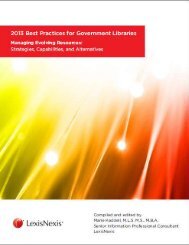2012 Best Practices for Government Libraries
2012 Best Practices for Government Libraries
2012 Best Practices for Government Libraries
You also want an ePaper? Increase the reach of your titles
YUMPU automatically turns print PDFs into web optimized ePapers that Google loves.
Considering Access During a Library Merge<br />
175<br />
BEST PRACTICES <strong>2012</strong><br />
By Rebecca Aftowicz, Reference Librarian, Comptroller of the Currency Library, with<br />
contributions from Joseph Thornton, Library Technician, Comptroller of the<br />
Currency Library<br />
Change can always be challenging, especially in a work environment. There may<br />
be some who are resistant or some who can feel too personally about a decision.<br />
In the case of my employer and the library staff, we had no choice but to adapt<br />
quickly to the fast-paced organizational changes, and we had to adjust so we could<br />
continue to serve our library customers. On July 21, 2010, President Obama signed<br />
Public Law 110-203, the Dodd-Frank Wall Street Re<strong>for</strong>m and Consumer Protection<br />
Act which, among other things, abolished the Office of Thrift Supervision (OTS).<br />
Many of the agency's functions were transferred to the agency where I work, the<br />
Office of the Comptroller of the Currency (OCC), including the functions of the OTS<br />
Library. The merge had to complete by July 21, 2011, and the library transfer had<br />
to occur by December 31, 2011.<br />
When thinking of merging the physical collections of two libraries, one of our<br />
biggest (and most obvious) concerns was space. Not only did we have to consider<br />
the amount of space in the OCC's current location, but we also had to consider our<br />
next move. The OCC is currently in the process of relocating all of its headquarters<br />
offices a few blocks away to another building- with a brand new library.<br />
Fortunately, the linear feet of the new OCC Library will be more or less the same<br />
as the current location, but this was just one other thing to consider during the<br />
transition.<br />
We began by measuring the linear feet of our current space - both the occupied<br />
shelves and the free space. I met with Joseph Thornton, the solo librarian at the<br />
OTS, to assess the collection and, first, determine the must-have materials to<br />
move. Joseph and I measured the linear feet of all the unique historical material of<br />
the Office of Thrift Supervision and Federal Home Loan Bank Board such as internal<br />
documents and publications. (History note: The Office of Thrift Supervision used to<br />
be the Federal Home Loan Bank Board.) We also reviewed the linear files with rare<br />
legislative materials. Then we determined how much space we would need at the<br />
OCC Library <strong>for</strong> any additional materials.<br />
While we were reviewing the two collections, our Technical Services unit (which is<br />
comprised of contractors) was immensely helpful and added their knowledge and<br />
experience to the move. They did a comparison of both agencies’ periodical<br />
holdings, created documents to show exactly how the linear feet of each library was<br />
utilized, and pulled monographs to transfer. Especially given the time constraints in<br />
this project, their assistance was invaluable.



